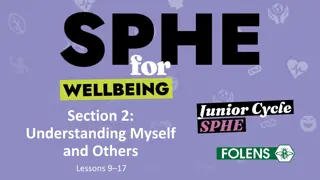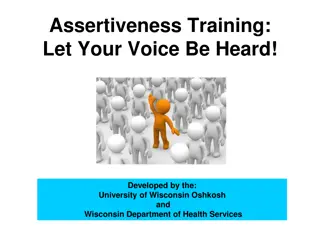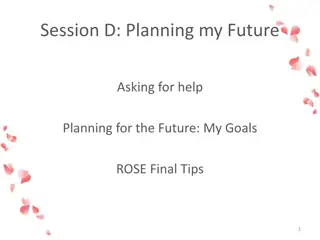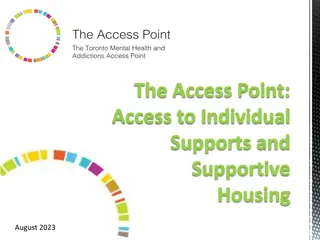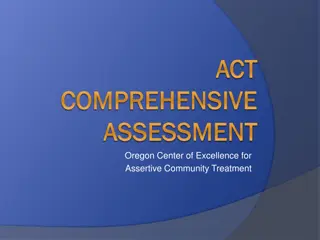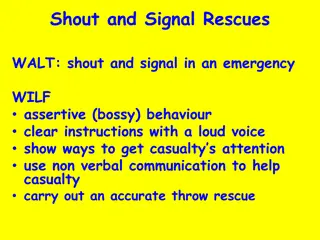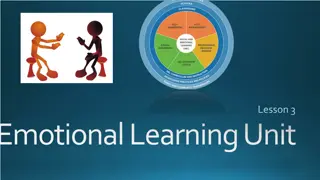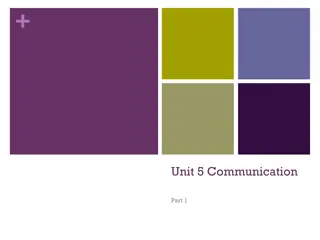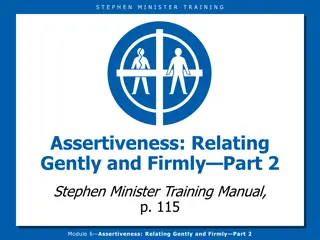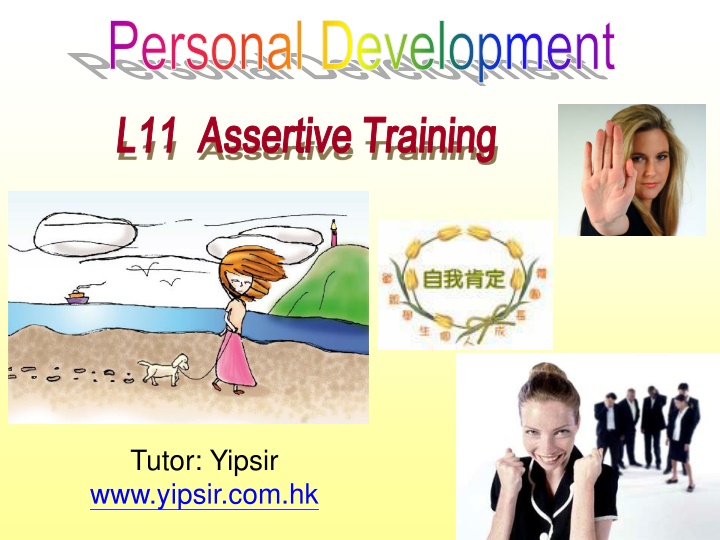
Assertiveness Training for Personal Development
Discover the essence of assertiveness - being positive, confident, and true to yourself. Learn how to express feelings effectively, handle negative situations, and measure your assertiveness through an inventory. Enhance your assertiveness skills for personal growth and empowerment.
Download Presentation

Please find below an Image/Link to download the presentation.
The content on the website is provided AS IS for your information and personal use only. It may not be sold, licensed, or shared on other websites without obtaining consent from the author. If you encounter any issues during the download, it is possible that the publisher has removed the file from their server.
You are allowed to download the files provided on this website for personal or commercial use, subject to the condition that they are used lawfully. All files are the property of their respective owners.
The content on the website is provided AS IS for your information and personal use only. It may not be sold, licensed, or shared on other websites without obtaining consent from the author.
E N D
Presentation Transcript
Personal Development L11 Assertive Training L11 Assertive Training 3-1 Tutor: Yipsir www.yipsir.com.hk 1
What is Assertiveness , 2
WHAT IS ASSERTIVENESS? Being assertive means to be positive and confident. Assertiveness begins by being aware that you are a worthy person created by GOD. You have your very own special gifts. Only you have your unique combination of qualities. 3
WHAT IS ASSERTIVENESS? You show strength not to let others hurt you or influence you in negative ways. Assertiveness is expressing your own ideas, opinions, and talents. When you are assertive, you don t follow others. You think for yourself. If someone is trying to hurt you, or lead you into trouble, or influence you to do something wrong, you protect yourself. 4
THE INVENTORY This is an instrument for measuring your assertiveness. For the questions below, use the following scale: 5 if behavior almost always occurs 4 if behavior generally occurs 3 if behavior sometimes occurs 2 if behavior rarely occurs 1 if behavior never occurs 5
Areas of Assertiveness: A. Expressing Positive Feelings: _____1. I give compliments easily and sincerely. _____2. I can tell people that I care about them. * _____ 3. I usually feel critical towards others. * _____4. I can think of more negative characteristics of myself than positive. _____5. I tell teachers when I like a course. * _____6. It s hard for me to tell my parents and family how much I love them. 6
B. Expressing Negative Feelings 7. If I get defective merchandise from a store, I can return it easily. _____ 8. If my food comes differently than I ordered, I send it back. _____ 9. I can disagree with people. *_____ 10. If there is something I don t like about a course, I usually don t say anything to the teacher, but I complain to other students. 7
* _____ 11. If a family member of a close friend s is annoying me, I usually pretend not to be bothered. * _____ 12. I smile even when I am not happy. * _____13. I find it difficult to negotiate prices for purchases, services, or repairs. * ____ 14. When people cut in line in front of me, I usually let them. 8
C. Setting Limits: * _____ * _____ 15. 16. I have a hard time saying no. I get involved in activities merely because someone I know asked me to. If I get invited somewhere and do not want to go, I usually make up a story and beg off. I can say sincerely to people No thanks, I am not interested. I know how much I can handle and am careful not to take on too much. * _____ 17. _____ 18. _____ 19. 9
D.Self-Initiative: _____ 20. I think of new projects or activities and then do them. _____21. I can ask a member of the opposite sex for dates. *_____22. I feel left out because not many people invite me places. _____23. I easily initiate conversations with new people. *____24. I have a difficult time meeting new people. Total Score ______ 10
indicates reverse scoring: * 1 if behavior almost always occurs 2 if behavior generally occurs 3 if behavior sometimes occurs 4 if behavior rarely occurs 5 if behavior never occurs 11
INTERPRETATION*** 100-120 You always stand up for yourself and take initiative, but you may overdo it at times and be aggressive. You may need to practice letting others take charge at times and not always saying everything negative that comes to mind.. 12
61-99 You are probably quite assertive and use appropriate behaviors. You do not often overdo it, so you are rarely aggressive and you also usually stand up for your rights, but are respectful of other people at the same time 13
24-60 You are too passive and let other people make decisions for you and/or control your life. You need to try not to please others so often and take more initiative in relationships 14
WHY PRACTICE ASSERTIVENESS? Without Assertiveness, we would be passive. We would let others boss us around. Without assertiveness we would just react to the things that other people expect of us. Others would tell us what to do and what to think. We wouldn t stop to figure out what we want, need or think. 15
WHY PRACTICE ASSERTIVENESS? The trouble with being too passive is that your special way of being yourself and thinking would remain unexpressed and the world would be a poorer place. 16
WHY PRACTICVE ASSERTIVENESS? When you are assertive, others respect you. You are offering your true ideas and feelings as well as protecting yourself from things that can cause you harm. 17
WHY PRACTICE ASSERTIVENESS? When you are assertive you choose what to say ( ) and what to do ( ) for reasons of your own. Just as each instrument in an orchestra is needed to make beautiful music, your part is needed in the song of life. 18
HOW DO YOU PRACTICE IT? You are your own leader. Being assertive does not mean you control things or always get your own way. 19
HOW DO YOU PRACTICE IT? When someone suggests something that makes you feel uneasy, might hurt you or get you into trouble, you stop and think. You tell them you won t do it. You don t let other people bully, or hurt you. 20
In short, assertion is.. Is standing up for oneself in a way that does not violate the basic rights of another person. It is a direct, honest, and appropriate expression of one s feelings and opinions. 21
(1, 3, 5, 12) 1 3 5 12 22
1 1. To be assertive, you need to remember how worthy you are. 2. You stand up for what you know is right. 3. You don t allow others to treat you unjustly. 4. You set limits with others by letting them know what you will and will not do. 5. When you have ideas, you speak out. 23
3 24
1. Passive (submissive, non assertive) You hide your feelings from others, you let others push you around and you do what you are told regardless of how you feel about it. Advantage: you are rarely rejected. Disadvantage : you store up resentment and anger. 25
2. Aggressive You express your feelings or opinions without regard for other people s right to be treated with respect. Advantage: People do not push the aggressive person. Disadvantage: People avoid contract with such person 26
3. Assertive You express your true feelings and do not allow others to take advantage of you. 27
Film show 28
5 1. 2. 3. 4. 5. 6. 7. 30
Assertive Techniques 1. Signposting 2. Self-disclosure 3. Basic assertion 4. Empathy 5. Workable compromise 31
1. Signposting () 1. This means telling the other person which way you are going in the conversation (about to ask a question, summarize, point out something). 2. This helps clarify the communication process, and helps to stress that you are communicating openly. When being overwhelming by a pressing sales or a voluble friend. 32
2. Self-disclosure () Along with signposting, self-disclosure allows you to tell a little bit about yourself such as using That concerns me .. I feel uncomfortable when you speak that way can also be used in giving appreciation and reprimands to others. 33
3. Basic Assertion 1. Stating clearly, concisely and usually without justification, what you want, what you think or how you feel. 2. Use this at the start of a conversation or when your views are in danger of being ignored. Some conditions like making a request for service or demand for a refund. 34
4. Empathy. 1. Letting someone else know that you can and do appreciate their position while taking care not to come across as patronizing or condescending. 2. You can do this by saying, Gee I realize how hard it is for you .. , Wow you have had a rough go at it 35
5. Workable compromises. 1. Broken Record 2. Fogging 3. Negative Assertion or Agreement 4. Negative Enquiry / Probing 36
5.1 Broken Record What is it? Repeatedly stating what you want, what you think or how you feel Use it when You need to be persistent. When you want to avoid playing their game or falling into their trap Hard sales, demand for a refund of defective goods, rejecting a request. 37
5.1 Broken Record . ( ) ( ) 38
5.2 Fogging What is it? Reflecting back what the other person has said, possibly paraphrased into more rational/factual or less emotive terms Use it when... You want to resist the temptation to become emotionally involved. You want to show that emotional put-downs have zero impact on you. 39
5.2 Fogging .. .. .. 40
5.3 Negative Assertion or Agreement What is it? Agreeing with the other person s comment or with the truth in what they have said Use it when You want to sidestep a barbed comment, show such comments or tactics have no effect on you, refocus the conversation onto a rational level 41
5.3 Negative Assertion or Agreement ( / ) ... 42
5.4 Probing / Negative enquiry What is it? Asking open questions (why, what, how, etc) to encourage the other person to be more specific Use it when You want to avoid responding or counter attacking. You want to put the onus on the other person to justify what they said. You want to move the conversation from an emotive to a rational level 43
5.4 Probing / Negative enquiry ( / ) ? ? 44
Tips for being Assertive Be firm, but polite 1. Do not over rely upon friendship 2. Be honest about limitations 3. Start small 4. Be specific 5. Be direct 6. Narrow your goals 7. State your reasons 8. Speak softer and slower 9. 45
Tips and Techniques 1. Take your time when you are learning assertiveness 2. Practice in small ways 3. Remember: eye contact, tone, body language. 4. Be clear and use I statements 5. Breathe, sometimes relaxation techniques work 6. Take a break after you have been assertive to recollect your thoughts and ask yourself did I clearly communicate my needs? 46
Scenarios 1. Time after time Your always late friend is-surprise- nowhere in sight for your 6 o'clock dinner date. By the time she breezes in at 6:45, you're in a sweet hurry to tell her how you feel. 2. A dress you ve worn only once has started to fray ( ) at the seams( ). You take it back to the store but the salesperson refuses to give you a refund. Your patience, like your dress, is starting to unravel ( ). 47
Your turn! 1. Think of 2 situations in which you have been unable to be assertive but would like to be. 2. Specify your goals 3. What were the imagined consequences of being assertive in each situation? 48
12 Assertive Rights 49
Rights and Responsibilities 1. You have the right to put yourself first sometimes 2. You have the right to make mistakes 3. You have the right to be the final judge of your feelings and accept them 4. You have the right to your own opinions 5. You have the right to change your mind 6. You have the right to protest unfair treatment 50




